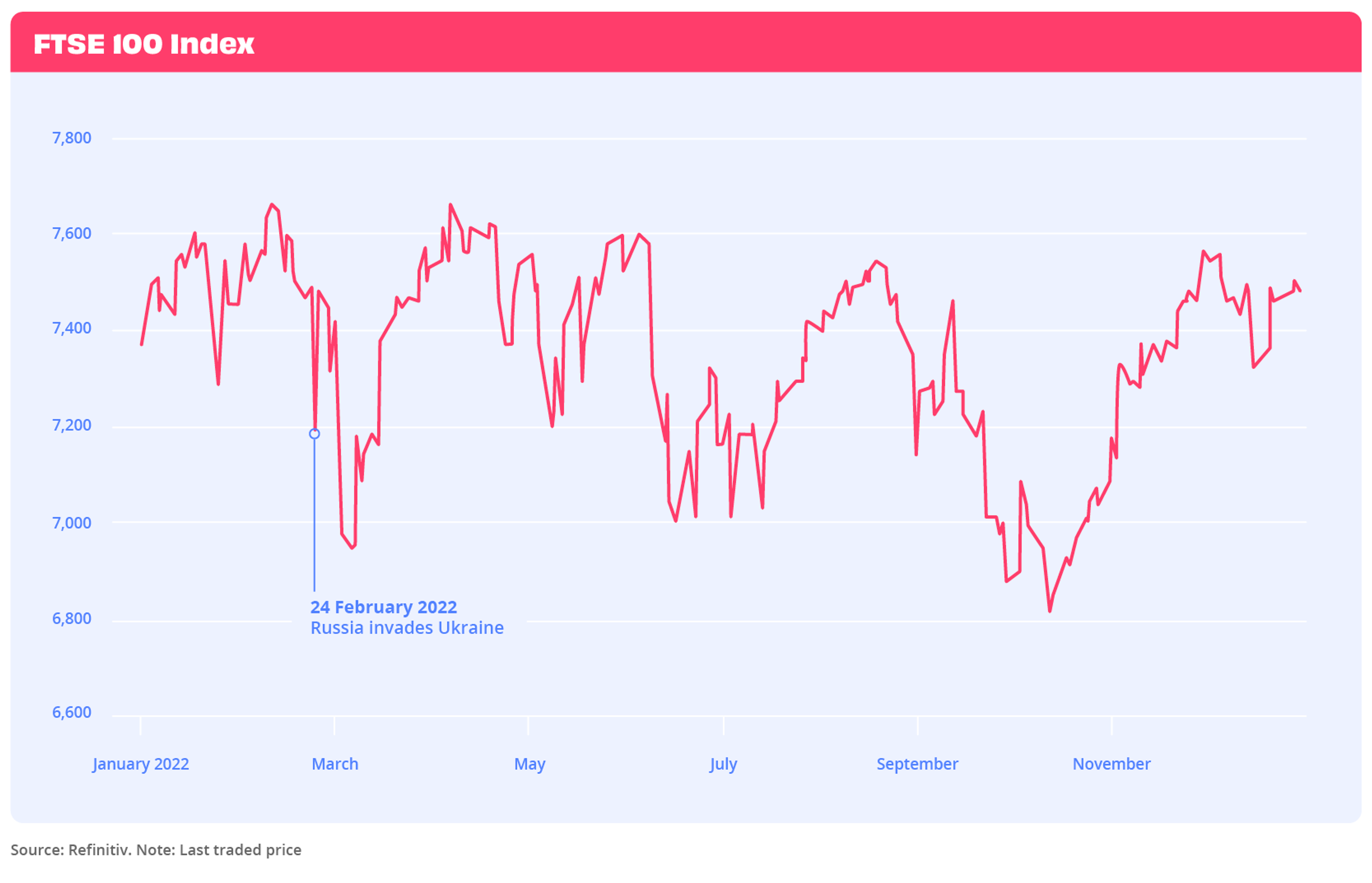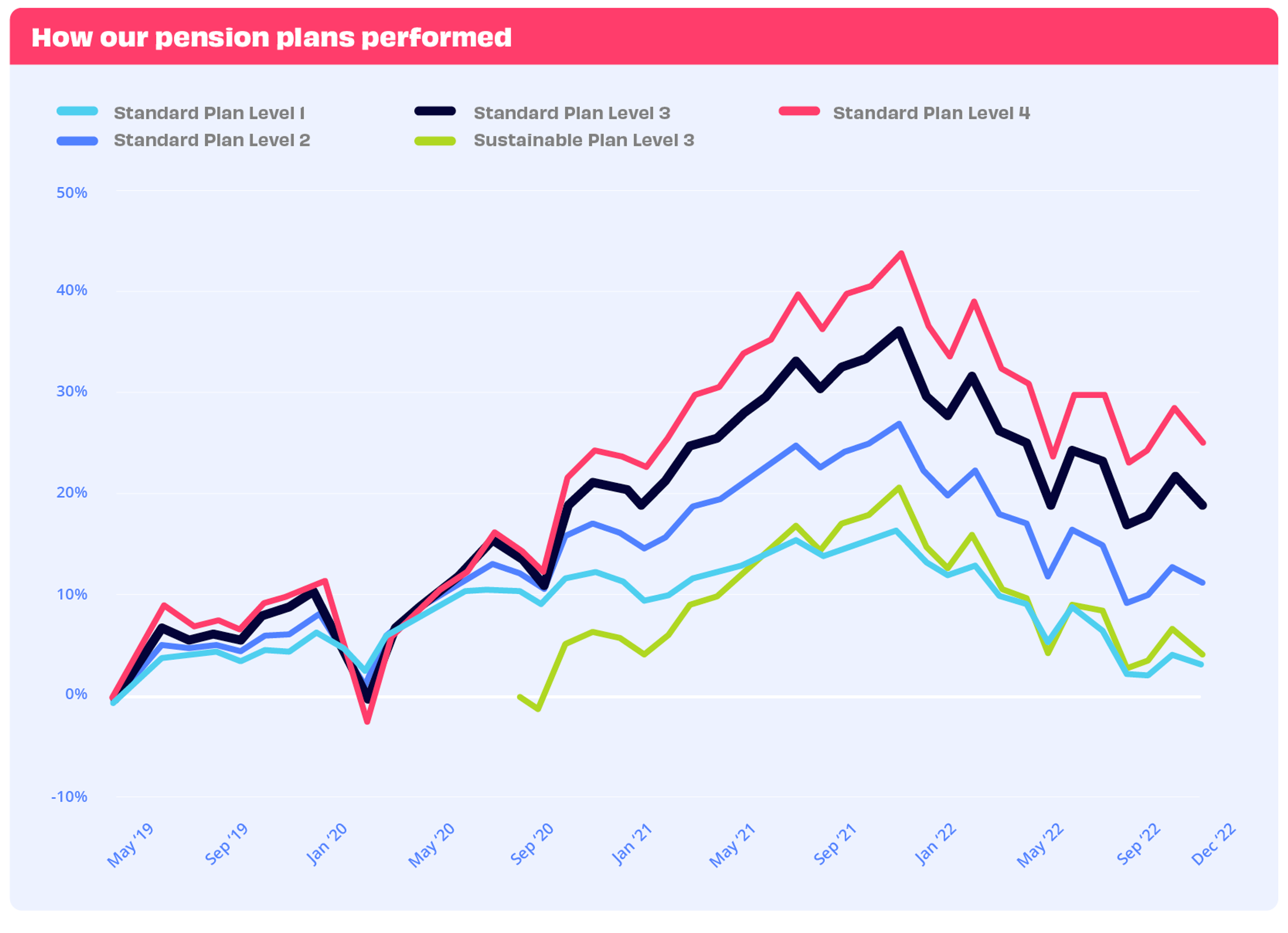Pension performance update: December 2022
- By
- Murray Humphrey

This monthly summary aims to give you a general understanding of the market landscape and help you to make informed decisions when it comes to your pension. Here's a brief snapshot of what happened with the leading indices in the UK and US, and an update on the performance of Penfold's pension funds.
Understanding December’s market dynamics
Last year was a tricky one for financial markets as they faced a few different challenges. The invasion of Ukraine dampened global economic prospects, and inflation soared, fuelled by rising commodity prices and supply chain disruptions. At the same time, central banks raised interest rates to contain the rise of prices, with a subsequent slowdown in consumer spending and investment activity.
Meanwhile, geopolitical tensions, local political instability and forecasts of an impending recession added further volatility to already uncertain markets. These factors combined to make for a challenging year for investors and market participants, with many finding it difficult to navigate the volatile and rocky conditions.
December has not been an exception. In fact, despite the November rally for both equities and bonds, in the last month of 2022, we saw a price correction for global markets, showing that volatility is still with us.
Pension funds also faced a similar scenario, experiencing a slight decline in December but maintaining some of October’s gains.
The US market downfall
In December, the S&P 500 index, which is considered a leading indicator of the overall performance of the US stock market and is often used as a benchmark for the broader stock market's performance, saw a decrease of 5.90%.

So, in the face of November's rebound, the S&P 500 return for 2022 has been -19.44% - making it the worst performance since the 2008 financial crisis.
However, despite the adverse market performance of this year, it's essential to consider the historical context. The US equity market has seen an impressive 90.13% growth in the past three years. And over a five-year period, the market has seen an overall gain of 112.89%. While negative returns can be concerning, it is worth noting that stock market fluctuations, including one year’s worth of poor performance, are a normal part of investing.
But why are we that concerned about the S&P 500? Because it represents a large portion of Penfold pension plans and can provide a good indication of their performance. It's also essential to remember that these plans are diversified to mitigate market risk and include investments in a variety of asset classes and markets worldwide, meaning that the correlation between the S&P 500 and the overall value of your pension is not 1-to-1.
The UK market showed resilience
Despite the general roller coaster experienced at both local and international levels (recession fears, the spike in inflation, and political chaos with three different PMs in just eight weeks), the UK market ended 2022 with decent performance.
The FTSE 100, an index of the 100 largest companies listed on the London Stock Exchange (LSE), closed the year 0.9% higher than twelve months before. While it's a very modest gain, which was mainly driven by the significant uptick in the share prices of energy and mining companies, it remains substantial compared to the results of the US and European markets.
Also in this case the performance of the market had an impact on pension funds but with a smaller effect than the US markets, as the allocation of UK equities within Penfold's funds is pretty limited.

How our pension plans performed
After experiencing a positive rebound in November, our pension plans saw a slight decrease in value during December.
Although the first half of the year was marked by a considerable downturn due to the impact of global financial markets and as a normal correction after exceptional growth in 2021, the second half has shown signs of stabilisation, which may indicate a potential reversal of the downward trend in the coming months.

Zooming out and looking at a longer time frame is particularly useful during periods of volatility. By observing the chart above, you can see the percentage changes in five of our pension investment plans since their inception, showing that despite the global upheaval of the last twelve months, the summary of the last few years is still positive.
It’s easier said than done, but it’s also always good to remember that short-term fluctuations in long-term investments should not cause too much stress.
Global markets forecast for 2023
As we have seen, global financial markets are currently experiencing a lot of uncertainty, with forecasts for future performance varying widely. That said, there are three predictions for 2023 that we are bearing in mind for the year ahead:
- Uncertainty remains high
Predicting the market in 2023 is like trying to hit a moving target. Even with the best information and analysis, there is so much going on at the moment that there will always be uncertainty and the possibility of unexpected events or changes that can impact the markets. - Central banks are expected to shift their monetary policy
With inflation finally peaking and seemingly slowing down in most countries, the expectation is to see the Fed, and other central banks around the world, pivot their strategy and start gradually cutting back interest rates. That's potentially good news as lowering interest rates tends to indirectly lead to a sustained recovery of asset prices, such as stocks and real estate, and therefore your pension funds. Will this actually happen? No one knows, but we can at least hope for it. - The markets will start to stabilise
Unfortunately, a strong rebound similar to what we experienced at the 2020 market crash is unlikely to happen in the short term. Having said that, we are optimistic that 2023 will bring a degree of stabilisation and consolidation as markets and investors have time to absorb and adapt to the economic changes. The global financial system is anticipated to find a new balance, providing a more stable environment for markets and investors.
All in all, while we may not have a crystal ball, we promise to keep a close eye on the market and keep you updated on the latest developments so that you can make your own informed decisions. So please sit back, relax, and let us do the heavy lifting.
With investments, your capital is at risk. The value of your investment can go down as well as up, and you may get back less than you invest. This information should not be regarded as financial advice and past performance is not a reliable indicator of future performance.

Murray Humphrey
Penfold